Showing Results in:
- ENGLISH
- SEE TRADITIONAL
- SEE CANTONESE
-
Tone
Phonetics: Tone colors (āáǎàa):
Recent Searches:
Learn more about 脊椎
- Written Chinese
- Dictionary
- "脊椎" Character Details
| Pinyin | Yale | Jyutping | English Definition for Chinese Text |
|---|---|---|---|
| jek3, jik3 cheui4, jeui1 | zek3, zik3 ceoi4, zeoi1 | vertebra / backbone |
| Simplified Chinese | Pinyin | Yale | Jyutping | English Definition for Chinese Text |
|---|---|---|---|---|
| jek3, jik3 | zek3, zik3 | spine / back / ridge / Taiwan pr. [ji2] or [ji3] | ||
| cheui4, jeui1 | ceoi4, zeoi1 | spine |
How do you remember 脊椎 ?
Post your photos, example sentences and daily homework here to share with the Chinese learning community.
How to use 脊椎 in a Sentence
- 远 yuǎn
- 端 duān
- 十 shí
- 二 èr
- 指 zhǐ
- 肠 cháng
- 及 jí
- 空 kōng
- 肠 cháng
- 仍 réng
- 处 chǔ
- 于 yú
- 脊 jǐ
- 椎 zhuī
- 右 yòu
- 侧 cè
- . .
The distal duodenum and jejunum remain on the right side of the spine.
- 远 yuǎn
- 端 duān
- 十 shí
- 二 èr
- 指 zhǐ
- 肠 cháng
- 及 jí
- 空 kōng
- 肠 cháng
- 仍 réng
- 处 chǔ
- 于 yú
- 脊 jǐ
- 椎 zhuī
- 右 yòu
- 侧 cè
- 。 。
The distal duodenum and jejunum remain on the right side of the spine .
- 脊 jǐ
- 椎 zhuī
- 之 zhī
- 间 jiān
- 的 de
- 基 jī
- 状 zhuàng
- 物 wù
- 起 qǐ
- 着 zhe
- 旋 xuán
- 转 zhuǎn
- 枢 shū
- 轴 zhóu
- 的 de
- 作 zuò
- 用 yòng
- . .
The disks between the vertebrae serve as the pivots of rotation.
- 这 zhè
- 一 yī
- 动 dòng
- 作 zuò
- 舒 shū
- 展 zhǎn
- 脊 jǐ
- 椎 zhuī
- , ,
- 使 shǐ
- 脊 jǐ
- 神 shén
- 经 jīng
- 更 gèng
- 加 jiā
- 强 qiáng
- 健 jiàn
- 。 。
This movement lengthens your spine and tones the spinal nerves.
- 两 liǎng
- 组 zǔ
- 都 dū
- 具 jù
- 有 yǒu
- 通 tōng
- 常 cháng
- 脊 jǐ
- 椎 zhuī
- 动 dòng
- 物 wù
- 才 cái
- 具 jù
- 备 bèi
- 的 de
- 两 liǎng
- 个 gè
- 特 tè
- 征 zhēng
- 。 。
Both groups share two attributes normally associated with vertebrates.
- 脊 jǐ
- 椎 zhuī
- 动 dòng
- 物 wù
- 脑 nǎo
- 子 zǐ
- 的 de
- 这 zhè
- 一 yī
- 部 bù
- 分 fēn
- 可 kě
- 分 fēn
- 为 wéi
- 两 liǎng
- 部 bù
- 分 fēn
- : :
- 脑 nǎo
- 髓 suǐ
- 和 hé
- 小 xiǎo
- 脑 nǎo
- . .
This part of the vertebrate brain has two divisions, the medulla and the cerebellum.
- 在 zài
- 蚯 qiū
- 蚓 yǐn
- 和 hé
- 许 xǔ
- 多 duō
- 其 qí
- 它 tā
- 无 wú
- 脊 jǐ
- 椎 zhuī
- 动 dòng
- 物 wù
- 中 zhōng
- , ,
- 这 zhè
- 些 xiē
- 排 pái
- 泄 xiè
- 结 jié
- 构 gòu
- 称 chēng
- 为 wéi
- 肾 shèn
- 管 guǎn
- . .
In the earthworm and many other invertebrates, these excretory structures are called nephridia.
- 出 chū
- 乎 hū
- 意 yì
- 外 wài
- , ,
- 脊 jǐ
- 椎 zhuī
- 动 dòng
- 物 wù
- 生 shēng
- 理 lǐ
- 学 xué
- 家 jiā
- 和 hé
- 微 wēi
- 生 shēng
- 物 wù
- 生 shēng
- 化 huà
- 学 xué
- 家 jiā
- 找 zhǎo
- 到 dào
- 了 le
- 共 gòng
- 同 tóng
- 阵 zhèn
- 地 dì
- . .
Quite unexpectedly, vertebrate physiologists and microbial biochemists had found a common ground.
- Chinese Characters with 1 Stroke
- Chinese Characters with 2 Strokes
- Chinese Characters with 3 Strokes
- Chinese Characters with 4 Strokes
- Chinese Characters with 5 Strokes
- Chinese Characters with 6 Strokes
- Chinese Characters with 7 Strokes
- Chinese Characters with 8 Strokes
- Chinese Characters with 9 Strokes
- Chinese Characters with 10 Strokes
- Chinese Characters with 11 Strokes
- Chinese Characters with 12 Strokes
- Chinese Characters with 13 Strokes
- Chinese Characters with 14 Strokes
- Chinese Characters with 15 Strokes
- Chinese Characters with 16 Strokes
- Chinese Characters with 17 Strokes
- Chinese Characters with 18 Strokes
- Chinese Characters with 19 Strokes
- Chinese Characters with 20 Strokes
- Chinese Characters with 21 Strokes
- Chinese Characters with 22 Strokes
- Chinese Characters with 23 Strokes
- Chinese Characters with 24 Strokes
- Chinese Characters with 25 Strokes
- Chinese Characters with 26 Strokes
- Chinese Characters with 27 Strokes



